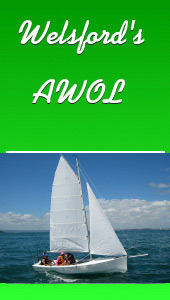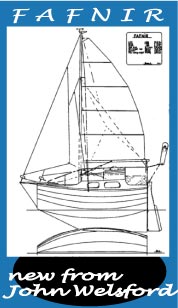
 Custom Search
|
| sails |
| plans |
| epoxy |
| rope/line |
| hardware |
| canoe/kayak |
| sailmaking |
| materials |
| models |
| media |
| tools |
| gear |
| join |
| home |
| indexes |
| classifieds |
| calendar |
| archives |
| about |
| links |
| Join Duckworks Get free newsletter CLICK HERE |
|
|
| Memories of Last Summer |
by John Welsford - Hamilton - New Zealand |
Part 1 - Part 2 - Part 3 - Part 4 - Part 5 Part 1: Getting Underway Lawn mowed -Check! Vegetable garden weeded - Check! Leaky tap fixed - Check!
The list had seemed endless, but it was all done at last. I’d already put the stores in the galley box, frozen up two 3 litre containers of water to keep the icebox cool, frozen the meats and milk, and refilled the outboard motor fuel can with fresh “juice”. I’d used the old stuff in the weedwhacker over the winter to ensure that I would not be caught out with stale gas. Lots more, but I was at last all ready, hooked up, a kiss and hug from wife Denny and I’m off down the road. The plan was for 8 nights away, day one drive to Auckland and sail to Waiheke Island about 20 miles out. That’s nautical miles so they are big ones, it meant that I’d need to be on the water and sailing by midday or I’d be knocking around the anchorage on a moonless night trying to find a clear space in which to anchor for the night. I had promised to pick up my friend Bruce Woods and take him sailing for the day, that would be day two. I’d purchased the little 18ft long keeled gaff sloop from him the year before, and part of the deal was that I’d take him out sailing for two weekends each year. He had found her a heavy lump to handle on his own, hard to launch and retrieve, even harder to rig with the mast and rigging weighing in at just over 50 lbs and the leverages all the wrong way when standing the mast up, that plus some other issues meant that Spook was just not the right boat for him. To keep her in the family, and to enjoy her positive points we’d done a deal, I own her, maintain her, sail her, and take him out sailing. He’s good company so its a good arrangement all round. I cast off from the inner harbour boat ramp at about 1 pm, my friend taking the car and trailer to his home for the week, (thanks Blair) and I was off down the harbour with a fresh breeze over the boats stern. We have a 12 ft tide here, so when anchoring Spook we’re often well our from the shore and I’d found swimming ashore with clothes in a drybag tedious, so had built a little tender which would be towed behind the mothership. This was the debut cruise for the tiny dinghy that I’d built the week before, some scraps of ply left over from other builds (her name is “Offcuts”, that should say it all) and about 15 hours of occasional labour had produced a tiny rowing boat that fitted into the cockpit of the mothership when she was on her trailer, I’ve no roofrack on the car so that was the best solution. Offcuts had been launched a couple of days before, just to check that she floated right way up and that I could row her, so to have her bouncing along behind dry, straight and well mannered was a relief. Two hours later I was off the southern end of Motuihi Island, that’s close to an 8 knot average which is really hauling for a heavy displacement 18 footer. She is though descended from the little working boats that were the fishermen and freighters of the English South coast in the late 1800s, working the rugged coast and rough seas of the English Channel so she has a good pedigree. This was only the second time I’d had Spook out in a reasonable breeze, she’d not been easy to handle when I got her, being heavy on the helm and difficult to keep on course both upwind and down, and I was pleased to find that the alterations I’d made in her trim, the set of the jib and the rake of the mast had greatly improved her manners as well as her speed. With Offcuts trailing obediently behind we turned in past Kennedy Point and into Putiki Bay, finding a sheltered spot in behind a group of moored boats, Spook only needs 2ft 6in of water to float so after a quick calculation as to the remaining tide, and some prospecting with a leadline we were anchored well inshore of the others but where we’d still have a couple of feet to spare under our keel at low tide.
Bruce had been keeping a watch for us, so after rowing Offcuts the couple of hundred yards around past the ferry wharf, waiting for the 250 ton twin hulled car ferry to come in and dock I pulled the little yellow dink up on the beach and tied her with the others lined up patiently awaiting their owners. I stayed at Bruce’s for supper, he’s a very good cook and doesn’t have the opportunity to show off very often, plus he’s a very good conversationalist. We had a nice evening talking boats and solving the problems of the world, Bruce was my course manager when I was teaching at University and he is the man responsible for getting me what might just have been the most fun job I ever had, teaching Marine Design to those kids was a real privilege and I think I learned more than the students did. I was up early next morning, picked Bruce up from the jetty and we spent the day gently exploring the little harbours and coves along the shores of the lovely island where he lives. It was a good day, and we’ll be doing it again this coming summer. Next: heading for Mahurangi John's Plans are in our Duckworks Store. |
|




